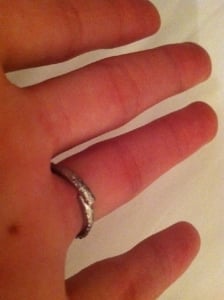I was standing up in a wedding this weekend and my 3 month old ring gradually became rough at the bottom (where a re-size had occurred) directly at the "6 o'clock" and eventually split. The split occurred at some point in the evening, but I assure you that I was not doing anything to cause impact to my hand. The split was so tight it was cutting off circulation on my finger, and the broken metal was causing severe pain to my hand, while I couldn't even slide it off. I went to a local jeweler the next day, and they were able to slide it off after significant amounts of Windex. The jeweler is refusing to take blame for the split, insisting I dragged it over concrete or inflicted trauma on the ring. There is literally nothing, aside from holding flowers and a microphone, that could have caused an impact on the ring. Have you heard of similar cases? Can a poorly re-sized ring cause a slit? We are just devastated.








300x240.png)